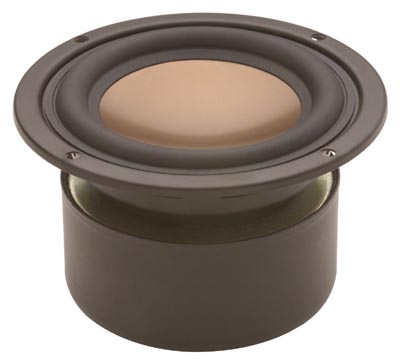 |
Hi-Vi Research C3N-III 3" Paper Cone Full Range
- Natural paper cone
- Magnetically shielded
- Rubber surround
- 91mm round flange (3.58")
- 71mm cut out hole (2.8")
- 53mm depth (2.09")
- Qts of of 0.955 would suggest a small sealed and stuffed enclosure, 1 to 2 liters


 |
- A full frequency design
- Advanced alloy (magnesium/aluminum) cone, coated with special damping material, and anodized.
- Optimum recovery CONEX supporting system, having very good stiffness and dynamic stability, improving the sonic features of the speakers.
- High power handling, heat-resistant Kapton Voice coil former and heat-resistant CCAW voice coil wire
- Finite Element Analysis for shielded magnetic system with long-throw linear excursion design
- Hi-Vi Symmetric Motor Drive (SMD) technology makes the voice coil into a symmetrical driving magnetic field, thus acquiring symmetrical driving force, reducing the mutual modulation of voice coil inductance and back electromotive force, improving the controllability of the speakers, achieving low distortion degree
- Finite Element Analysis for flat & rigid iron frame, prevents the parasitic structural resonances
- Using leading technology of Small/Thiele parameters
- Suitable for midrange, surround speakers a in home theatre system, and also suitable for computer multimedia speakers
- Nominal Impedance (Z)(Ω): 8
- Resonance Frequency (Fs)(Hz): 77
- Nominal Power Handling (Pnom)(W): 15
- Sensitivity (2.83v/1m)(dB): 81
- Weight (M)(Kg): 0.55
- VC Diameter (mm): 20 CCAW
- DC (Re)(Ω): 6.5
- VC Length (H)(mm): 9
- VC Former: Kapton
- VC Layers: 2
- Magnet System: Shielded Ferrite
- Force Factor (BL)(N/A): 3.1
- Gap Height (He)(mm): 3.0
- Linear Excursion (Xmax)(mm): 3.0
- Suspension Compliance (Cms)(uM/N): 1320
- Mechanical Q (Qms): 4.48
- Electrical Q (Qes): 1.07
- Total Q (Qts): 0.86
- Moving Mass (Mms)(g): 3.2
- Effective Piston Area (Sd)(m2): 0.0030
- Equivalent Air Volume (Vas)(L): 1.7
- Cabinet Type: Sealed
- Recommended Box Volume(Vb)(L): 2
- -3dB Cut-Off Frequency(F3)(Hz): 80
Diagram

Frequency

Impedance


Frequency

Impedance

No comments:
Post a Comment